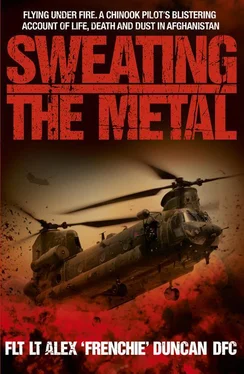All’s well that ends well, then.
A couple of days later, we flew a routine tasking out of KAF that saw me undertake a technique I’d never tried before, with the Chinook operating right on the very edge of its capabilities.
The airflow over a Chinook is at its most efficient when it’s off the 10 o’clock. This doesn’t mean that we fly sideways to achieve best-efficiency of the rotors, and anyway, the difference is so slight as to only really matter in extreme circumstances. I considered the circumstances extreme enough on this sortie, though, that I needed every bit of help I could get.
Alex and I were flying as No.2 to Hannah on a routine tasking day out of KAF. The bulk of the day was pretty uneventful – a series of routine admin and mail runs to various locations in the Upper Gereshk Valley. Our final sortie late in the evening saw us at Bastion where we lifted two cabs full of troops en route to Kajaki, where they were destined to relieve two units there that had experienced quite an intense period on the front line.
We flew the route from Bastion at high altitude as the ridges surrounding Kajaki Dam go up to 6,000ft plus. Hannah was ahead as lead and our Apache escort called the Widow call sign at Kajaki to obtain clearance. Hannah was cleared in straight away, while Alex and I went to hold further up the lake.
If I’m honest, we were more or less doing a bit of war tourism, so I wasn’t complaining. There are worse places to fly a holding pattern than over the forbiddingly beautiful lake and surrounding topography at Kajaki – it’s not like you could ever grow bored of the view. We ended up holding for some twenty minutes, a lot longer than expected, before Hannah advised us that she was lifting. I repositioned the aircraft at low level over the lake pointing to the south-west, in order to see her as she came out flying over the dam.
There are two ways in and out of Kajaki. You fly over the dam to get in, but as the landing site is so low in the valley, you need to watch your speed as you cross it and ensure it remains above 60kts or you end up flirting with Vortex Ring, a phenomenon in which the rotors lose lift at speeds below 30kts and a rate of descent above 500ft per minute.
There is however a sluice gate further to the east-north-east of the dam which is literally a cut in the mountain. You fly through it at 50ft with the sides of the mountain close on each side, pressing in on you and making you feel small even though you’re in 99ft of aircraft. You end up following the Helmand River as it winds down the valley, which increases the distance to the landing site and allows you to carry more speed on the approach. This is what I opted to do for my run in.
Everything has limits and that includes the Chinook’s capabilities. Regardless of what it can do in ideal conditions – cold and as close to sea level as possible – the higher and hotter you go, the greater the impact on what you can lift. So Afghanistan in summer – very hot and very high – is not exactly ideal. For this sortie, we were tasked and limited to picking up twenty-one soldiers.
As soon as I landed on, Bob came over the intercom. ‘Er, two minutes, Frenchie mate, we’ve got somebody approaching and he wants a chat. It looks like we’ve got at least thirty blokes here. I’m going off-intercom.’
Five minutes later, he’s back.
‘Okay Frenchie, this is the deal. We have twenty-one guys as flagged on the task sheet to go back to Bastion. We also have twelve guys with their kit for R&R. They didn’t get on a Chinook yesterday, as it broke down, so they missed their TriStar home. The dickhead in the tasking cell obviously didn’t think of putting them on another cab so they’re trying to hitch a ride.’
Shit. I don’t want to leave them here, but how the fuck am I going to get airborne with that many bodies?
‘Okay, let me think about it for a minute,’ I say.
The clock for R&R starts as soon as front line troops leave their units, so if they stay fourteen days at Kajaki, or their aircraft goes tech and they spend nine days waiting for a replacement, it makes no difference. Regardless of if or when they get home, as far as their parent unit is concerned they’ve had their fourteen days R&R. It sucks, but that’s how it is.
I want to take them but I have a problem: the aircraft’s available power. What we have in hand is enough for us to lift one-and-a-half tonnes above the limit given to me by the taskers and, if I’m honest, I’m not sure my trusty Chinook can even achieve that.
Things are compounded by our location; the only way out is up and over the dam. However the dam rises high ahead, with steep sides left and right and some wires strung across the wall and mountain sides. Then I recall a technique that I learned way back in my early days at RAF Odiham from Bill Thompson, my first instructor on the Chinook. He was old even then, but God that man knew how to fly. What he didn’t know was not worth knowing and he had probably forgotten more than I’ll ever learn.
We were on an instructional sortie and he showed me how to accelerate using the minimum of power by using the air cushion that builds up under the aircraft. Doing this, you build up enough speed to climb and you use the Chinook’s unique aerodynamic effect; the airflow from the 10 o’clock.
I look at Alex with this ‘trust me’ look in my eyes and say, ‘Okay Bob, we’ll take them and we’ll have a shot at clearing the dam. If we can’t make it, then we’ll come back here and I’m afraid they’ll have to wait for the next cab. But guys, as you know, R&R time is running out for them so we have to give it a go.’
As expected, the guys agree immediately. Now for the hard part. Bob gets them all on board. Thirty-three people and their kit instead of the twenty-one we were expecting. I’m not even sure this will work.
‘CAP, Ts and Ps, brakes off, clear lift?’ I check.
‘Clear above and behind,’ says Coops.
‘Lifting,’ I say, heaving on the collective. I can feel the aircraft is heavier immediately; the engine notes rise in pitch as both strain to deliver everything they have, and the lever in my hand is almost in my armpit. We are well into the ten-minute power band and only just in the hover.
‘Okay chaps, I’ll go down the river towards Kajaki town – not too far though, because we all know what a shithole it is. We’ll use that as the run-up and I’ll bias myself on the left-hand side of the dam. In the event that we run out of power and climb, I’ll be able to see clearly from the right-hand seat into a right-hand turn back to the landing site. Any questions?’
There are none. Good, as I’m not sure I’ve got any answers. This is unknown territory. I slowly hover-taxi down the river and turn the aircraft through 180° to face the dam. It looks intimidating ahead of us and as I look at it, I could swear that somebody has just built an extra 10ft on top. It looks like it’s daring me. Come and have a go if you think you’re hard enough . I hold us in the hover with nothing in reserve. Well, I can’t look at it forever so fuck it! I go for it.
I gently trickle the aircraft forward using the ground cushion; it’s a balancing act. I can’t dip the nose too hard or we’ll descend and I don’t have the power available to arrest the descent. If that happens, we’ll hit the river and I don’t even want to think about that.
Alex is calling the power settings to ensure that I use everything available. The speed is building. ‘Come on Frenchie,’ I think. ‘For once in your life be smooth.’ The speed continues to build… 60kts, and half the distance covered. I know that in about 10–15kts I’ll be at what we call minimum power speed; this is the speed at which most power is available, where the aircraft is at its most efficient. 65kts; 70kts. ‘Come on!’ 75kts; 80kts.
Читать дальше













